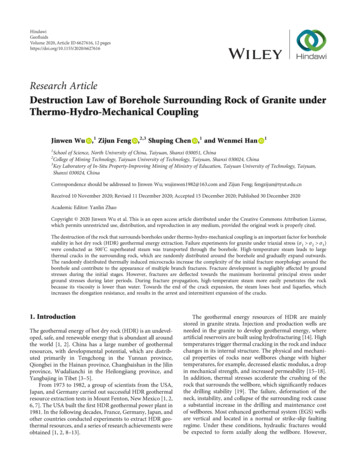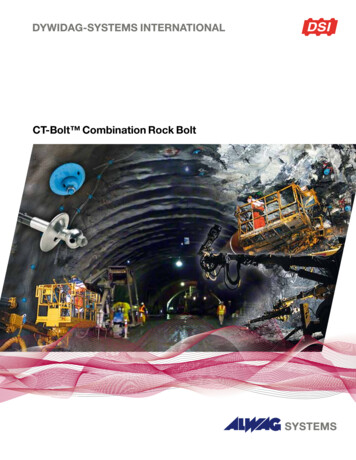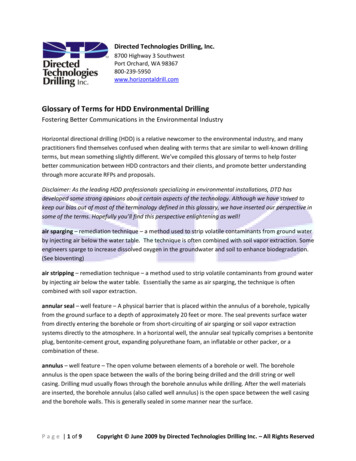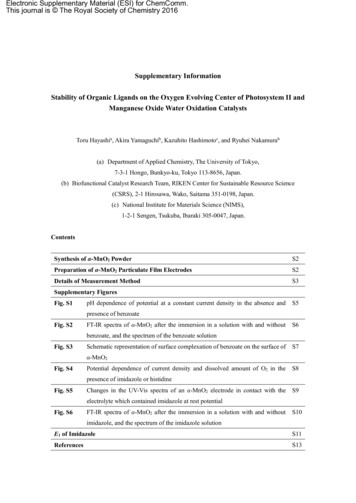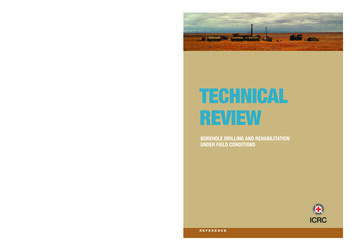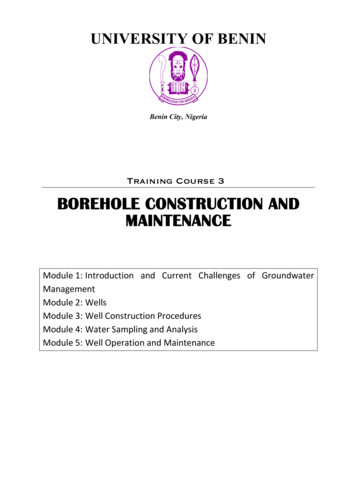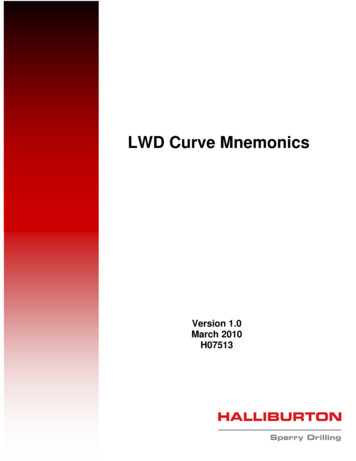
Transcription
COo3JmooBOREHOLE DATA-COLLECTION METHODSAPPLICABLE FOR THE REGIONAL OBSERVATIONAND MONITOR WELL PROGRAM,SOUTHWEST FLORIDA WATER MANAGEMENT DISTRICTo65XoOo COrmnO3JHXm3JmOOzOCD(/)m3JU.S. GEOLOGICAL SURVEYWATER-RESOURCES INVESTIGATIONS 81Oz zO2Oo3Jmo3DOOPrepared in cooperation with theSOUTHWEST FLORIDA WATER MANAGEMENT DISTRICT
50272-101REPORT DOCUMENTATIONPAGE3. Recipient's Accession No.1. REPORT NO.4. Title and Subtitle5. Report DateBOREHOLE DATA-COLLECTION METHODS APPLICABLE FOR THE REGIONALOBSERVATION AND MONITOR WELL PROGRAM, SOUTHWEST FLORIDA WATERMANAGEMENT DISTRICT7. Author(s)September 19818. Performing Organization Rept. No.John J. HickeyUSGS/WRI 81-579. Performing Organization Name and Address10. Project/Task/Work Unit No.U.S. Geological Survey, Water Resources Division325 John Knox Road, Suite F-240Tallahassee, Florida 3230311. Contract(C) or Grant(G) No.(C)(G)12. Sponsoring Organization Name and Address13. Type of Report & Period CoveredU.S. Geological Survey, Water Resources Division325 John Knox Road, Suite F-240Tallahassee, Florida 3230314.15. Supplementary NotesPrepared in cooperation with the Southwest Florida Water Management District16. Abstract (Limit: 200 words)Management of ground-water resources within the Southwest Florida Water ManagementDistrict requires that hydrogeologic characteristics of water-bearing rocks and qualitycharacteristics of water be described. Wells for the District's Regional Observationand Monitor Well Program are drilled specifically to collect data to describe the groundwater resource. Borehole data-collection methods for these wells include drilling instages; running geophysical logs at the completion of each stage; collection of waterlevel and specific-conductance data before, during, and after a day's drilling; specificcapacity determinations after a day's drilling; and placing a packer in the gypsiferousand anhydritic limestone and dolomite for water-level and water-quality data.17. Document Analysisa. DescriptorsDrilling, Borehole geophysics, Carbonate rocks, Floridab. Identifiers/Open-Ended TermsFloridan aquiferc. COSATI Field/Group18. Availability Statement19. Security Class (This Report)UNCLASSIFIEDNo restriction on distribution(See ANSI-Z39.18)20. Security Class (This Page)21. No. of Pages1422. PriceUNCLASSIFIEDSee Instructions on ReverseOPTIONAL FORM 272 (4-77)(Formerly NTIS-35)Department of Commerce
BOREHOLE DATA-COLLECTION METHODS APPLICABLE FOR THE REGIONALOBSERVATION AND MONITOR WELL PROGRAM, SOUTHWEST FLORIDA WATERMANAGEMENT DISTRICTBy John J. HickeyU.S. GEOLOGICAL SURVEYWater-Resources Investigations 81-57Prepared in cooperation with theSOUTHWEST FLORIDA WATER MANAGEMENT DISTRICTTallahassee, Florida1981
UNITED STATES DEPARTMENT OF THE INTERIORJAMES G. WATT, SecretaryGEOLOGICAL SURVEYDoyle G. Frederick, Acting DirectorFor additional information write to:U.S. Geological Survey325 John Knox Road, Suite F-240Tallahassee, Florida 32303
CONTENTSAbstractIntroductionGeneralized hydrogeologic setting of the Southwest Florida WaterManagement DistrictObjectives of borehole data collectionPractical limitations in achieving borehole data-collection objectivesBorehole data-collection methods. . . «. .«.» . . . » . .-» -» » *» i««»»»«» i "» «" "» «» "»"»"»« « Page1124451 ftAwILLUSTRATIONPageFigure 1.Map showing location of the Southwest Florida Water ManagementDistrict3TABLEPageTable1.Summary of borehole data-collection methodsiii9
BOREHOLE DATA-COLLECTION METHODS APPLICABLE FOR THE REGIONAL OBSERVATIONAND MONITOR WELL PROGRAM, SOUTHWEST FLORIDA WATER MANAGEMENT DISTRICTBy John J. HickeyABSTRACTManagement of ground-water resources within the Southwest Florida WaterManagement District requires that hydrogeologic characteristics of waterbearing rocks and quality characteristics of water be determined and described,Wells for the District's Regional Observation and Monitor Well Program aredrilled specifically to collect data to describe the ground-water resource.Borehole data-collection methods that can be used during construction of thesewells include drilling in stages; running geophysical logs at the completionof each stage; collection of water-level and specific-conductance data before,during, and after a day's drilling; specific capacity determinations after aday's drilling; and placing a packer in the gypsiferous and anhydritic limestone and dolomite for determining water-level and water-quality data.INTRODUCTIONManagement of ground-water resources within the Southwest Florida WaterManagement District requires that hydrogeologic characteristics of the waterbearing rocks and quality characteristics of the water be determined and described. Data for describing these characteristics come from boreholes. Generally, hydrolegists collect data from wells drilled to produce water ratherthan from wells drilled to acquire data. This is a limitation on hydrologicdata collection and is one of the principal reasons for creation of theDistrict's Regional Observation and Monitor Well Program (ROMP). Wells forthis program are drilled specifically to collect data to describe the groundwater resource.This report presents some borehole data-collection methods that can beused during the drilling of ROMP or other wells where data collection is a primeobjective. Hydraulic, water-quality, and geophysical data-collection methodsapplicable to the hydrogeology of west-central Florida are emphasized.All the methods have been used and tested during extensive drilling atproposed wastewater-injection sites in Pinellas County and at proposed phosphatemining sites in Manatee County. The following brief sketch of these methodswill not provide all data-collection answers, but can provide general guidelines for developing a data-collection program that can aid in achieving thegoals of ROMP.
The data-collection methods will not significantly increase the time neededto drill ROMP wells. If all methods were used, about 6 to 10 days might be added to the drilling time. This is a small increment, considering it could takefrom 90 to 180 days, or longer, to drill a well to the base of the Floridanaquifer in the Southwest Florida Water Management District. In practice, all ofthe methods probably would not have to be used during the drilling of every well.Prior hydrogeologic knowledge of the site and specific purpose of the ROMP wellwill guide the choice of methods used.Some examples of data collected using the suggested methods are publishedin William F. Guyton and Associates (1976a; 1976b), Hickey (1977; 1979), andHickey and Barr (1979).The author wishes to thank W. B. Smith, Senior Hydrologist, of the SouthwestFlorida Water Management District for his thoughtful comments during the preparation of this report.GENERALIZED HYDROGEOLOGIC SETTING OFTHE SOUTHWEST FLORIDA WATER MANAGEMENT DISTRICTThe Southwest Florida Water Management District (fig. 1) is underlain bythree principal lithologic sequences. They are from top to bottom: (1) Unconsolidated sand, clay, and marl with some interbedded limestone and dolomite;(2) limestone, dolomitic limestone, and dolomite; and (3) gypsiferous and anhydritic limestone and dolomite. Total thickness of all three sequences rangesfrom about 4,000 feet in the northern part of the District to more than 13,000feet in the southern part (Applin, 1951).Ground-water resources in the District occur within the two uppermostlithologic sequences. Generally, the resource extends to depths below landsurface not exceeding about 1,000 feet in the north and about 2,000 to 3,000feet in the south. Along the Gulf coastal margins and in some southern areasof the District, the resource is at substantially shallower depths.The surficial aquifer and the upper confining bed of the Floridan aquiferare in the uppermost lithologic sequence. The interbedded limestones and dolomites of this sequence occur in the southern part of the District within theupper confining bed of the Floridan aquifer. Locally, some of the limestoneand dolomite beds have water-producing intervals that are used as a source ofsmall water supply.The Floridan aquifer is in the lithologic sequence composed of limestone,dolomitic limestone, and dolomite. The upper part of the aquifer is generallylimestone, and the lower part of the aquifer is generally dolomitic limestoneand dolomite. Water-producing intervals occur at various depths in the aquifer.The producing intervals in the dolomitic limestone and dolomite are generallymore permeable than those in the limestone. Along coastal margins of theDistrict, it is particularly important to identify the depths of water-producingintervals because they are the principal conduits of lateral ground-water flowand may be subject to saltwater intrusion.
40 MILESFigure 1. Location of the Southwest Florida Water Management District.(District boundary is shown as solid line.)
The lower confining bed of the Floridan aquifer is in the lithologic sequence composed of gypsiferous and anhydritic limestone and dolomite. Generally,the lower confining bed contains very poor quality water with high chloride andsulfate concentrations.OBJECTIVES OF BOREHOLE DATA COLLECTIONObjectives of borehole data collection from ROMP wells in the SouthwestFlorida Water Management District are to:1.Determine thickness, lithology, and hydrologic properties of the surficialaquifer, the upper and lower confining beds of the Floridan aquifer, andthe Floridan aquifer;2.Determine depth of water-producing intervals within the upper confiningbed and Floridan aquifer and their relative producing capabilities;3.4.Determine chemical characteristics of water within the surficial aquifer,upper confining bed, Floridan aquifer, and the top of the lower confining bed;Determine direction of ground-water movement between the surficial aquifer and the Floridan aquifer, between water-producing intervals withinthe Floridan aquifer, and between the Floridan aquifer and the lowerconfining bed; and5.Verify construction of the borehole.PRACTICAL LIMITATIONS IN ACHIEVING BOREHOLE DATA-COLLECTION OBJECTIVESThe surficial aquifer and significant parts of the upper confining bed arecomposed of unconsolidated sediments, and boreholes in these are commonly drilledusing either conventional mud-rotary or cable-tool methods. Mud-rotary drillingprecludes water-quality determinations. Cable-tool drilling precludes the useof electric logs in the cased part of the hole, and the natural gamma ray, neutron, and gamma-gamma logs that can be run may be difficult to interpret becauseof the effects that the casing and disturbed beds have on the gamma and neutronflux.Identification of moderate- to low-yielding water-producing intervals belowhighly productive intervals in the Floridan aquifer is extremely difficult unless the higher zones are cased off. When pumped, most water produced in anopen hole will come from the highly productive intervals, assuming there islittle, if any, head difference between intervals.Determination of chemical characteristics of water with depth in theFloridan aquifer during drilling is hampered because differences in flow fromwater-producing intervals mask the natural vertical variations in quality withinthe aquifer. As mentioned above, when pumped, most water produced in an openhole will come from the highly productive intervals, assuming there is little,if any, head difference between intervals.
Some sections of limestone are friable, and borehole diameters are proneto enlarge to several times the bit diameter when drilled by the air reverserotary method. This problem is minimized when conventional mud-rotary orcable-tool methods are used. Some sections of dolomite are very fractured andborehole diameters may enlarge by collapse of the borehole wall during drilling.Large borehole diameters limit or negate interpretability of geophysical logsbecause the geophysical response of the borehole overrides response of adjacentbeds.Determination of vertical direction of ground-water flow is very difficultto accomplish during drilling because head measured in the borehole is a composite of all heads encountered.Improper site selection and preparation before drilling of test boreholescan significantly limit the achievement of data-collection objectives. Sitesshould be selected and prepared with specific objectives and data-collectionmethods in mind. For example, disposal of large volumes of pumped water oftenpresents problems on flat, poorly drained areas; and if chemical compositionof pumped water is significantly poorer than surface water or water in the surficial aquifer, special drilling and disposal methods may be required to preventenvironmental damage.BOREHOLE DATA-COLLECTION METHODSMud-rotary drilling facilitates data collection in the unconsolidated section because a suite of borehole geophysical logs can be run prior to settingcasing. Logs may include, as a minimum, caliper, single-point resistance, andnatural gamma ray. In addition, deep-focused and long- and short-normal resistivity could also be included; and if poor quality water is likely to be penetrated, a neutron log could be run for porosity estimates so that resistivitylogs can be interpreted to indicate depth of poor quality water. Resistivitymeasurements are related to formation water quality and porosity.Water-level and water-quality data from the mostly unconsolidated sectioncould be collected by drilling a minimum of two shallow wells. One well tappingthe surficial aquifer and the other tapping limestone and dolomite water-producing intervals within the upper confining bed of the Floridan aquifer could provide reliable data. Data-collection procedures for the latter well can betailored to suit local conditions by using procedures similar to those in theabove and following discussion.Air reverse-rotary drilling facilitates the collection of water-qualityand specific-capacity data in the consolidated carbonate section. Dischargeduring drilling should be as small as possible to limit washing out the friablelimestone. Prior to each day's drilling for the purpose of determining whetherpoor quality water has been penetrated, water samples can be taken, beginningafter the equivalent of one-half the drill stem volume has been discharged andcontinuing after each one-half drill stem volume and until several stem volumeshave been discharged. At the end of each day, a water sample can also be takenafter all cuttings have been removed from the hole. After analyzing all watersamples in the field for specific conductance, a comparison between the severalbeginning and the ending specific-conductance values may indicate whether poorquality water has been penetrated.
Static water-level measurements made before each day's drilling are recommended. Also, pumping water-level measurements made soon after the start ofdrilling and whenever a noticeable change in drilling rate occurs are recommended.An approximate measure of specific capacity can be calculated at the end ofthe day's drilling by measuring discharge after all cuttings have been removedand by measuring water levels at the time of the discharge measurement and about30 minutes after discharge ceases. A better determination of specific capacitycan be calculated by pumping the borehole after water levels have recovered froma day's drilling. A constant discharge rate of about 200 gallons per minute(gal/min) and water-level measurements taken before and during pumping for atleast 30 minutes may provide sufficient data. If water quality and, thus, density varies with depth, the borehole should be pumped in two steps with the discharge and water-level data from the second step used for calculating specificcapacity. The second step could start at any time after specific conductanceof the pumped water becomes constant. In this way, water-level changes causedby water-density changes would be minimized. When the first highly productivewater-producing interval is reached during drilling, subsequent specific-capacitydeterminations may be discontinued.The upper part of the Floridan aquifer is generally a limestone and thelower part is generally a dolomitized sequence composed of dolomitic limestoneand dolomite. Typically, the dolomitic sequence is more permeable than thelimestone. Because of this vertical difference in hydraulic properties, datacollection is improved by drilling Floridan aquifer boreholes in stages. It isrecommended that the first stage be drilled to the approximate base of the limestone. Then, a borehole geophysics survey can be performed including, as aminimum, static and pumping temperature, flow meter, caliper, and specific conductance.To insure that geophysical logs may be interpreted, the borehole shouldhave a diameter that generally does not exceed 12 inches and, if possible,should not exceed 8 inches. After drilling and pumping is completed, a minimumaf 1 day of rest should be allowed, to enable the head and temperature to stabilize,before the static-temperature log is run. The pumping temperature log can be runonly after at least five borehole volumes have been discharged at a minimum rateof about 200 gal/min to insure that temperatures measured are those of water inthe aquifer and not of the fluid in the borehole.Pumping at rates from 300 to 500 gal/min in boreholes ranging from 8 to12 inches in diameter may be sufficient for reliable flow-meter logs in the upper part of the Floridan aquifer. Continuous flow-meter logs are to be avoidedbecause they can be readily interpreted only when the borehole diameter is constant. The depth-stationary type of log generally gives the best results.Depths at which to place the flow meter can be determined from caliper andstatic- and pumping-temperature logs.During pumping for temperature and flow-meter logs, water-level measurements can be made in the well to provide an estimate of specific capacity andpossibly transmissivity of the open-hole section. When the hole is open onlyto the limestone, pumping rates of 200 to 500 gal/min may be sufficient tocause measurable drawdown changes with time. Water-level measurements shouldbe taken over a minimum duration of about 150 minutes from start of pumpingfor pumping test interpretation.
After water-producing intervals have been determined from either or boththe temperature and flow-meter logs, a deep well sampler can be used to collectwater samples from the lowermost producing interval. It is recommended thatsamples be measured in the field for temperature and specific conductance andanalyzed in the laboratory, as a minimum, for dissolved solids, chloride, sulfate, and water density.Upon completing data collection in the limestone, the borehole can then bedrilled, if necessary, through the dolomitized sequence and into the upper 200to 300 feet of the lower confining bed. A good index for identifying the topof the confining bed is the first presence of gypsum or anhydrite below thedolomitized sequence. The same geophysical logs and data-collection proceduresdiscussed above for the limestone are recommended. In addition, natural gammaray, deep-focused and long- and short-normal resistivity, and acoustic velocitylogs are also recommended.When the hole is open to the entire dolomitic sequence, discharge for apumping test would probably have to be in excess of that needed for a flowmeter log. A rate on the order of 1,000 gal/min or higher may be required formeasurable drawdown changes with time.After all other testing activities are completed, and again, if necessary,a packer at the end of the drill pipe can be placed into the hole below the firstpresence of gypsum for testing of the confining bed. Placement of the packerdepends upon the diameter and shape of the drilled hole, as determined from thecaliper log. Pumping of the open interval below the packer will enable one toobtain water samples for the same measurements and analyses mentioned above, anddrawdown can be measured at frequent intervals over a duration of about 1,000minutes for pumping test interpretation. Step-drawdown tests could also be performed when the packer is in place to estimate entrance and pipe losses. Becauselarge drawdowns would be anticipated, air-lift pumping probably would Tiave to beused. The rate of air-lift discharge may range from about 0.5 gal/min to about50 gal/min. Water-level recovery measurements probably should be made after allpumping ceases because they can be interpreted to suggest whether the zone belowthe packer was isolated from zones above the packer. A small diameter tubingdesigned to pass through the air-lift assembly and open to just above the packerwould allow water-level measurements to be made during pumping and recovery.Additional data-collection methods could be included for both the unconsolidated sand, clay, marl section and the consolidated carbonate section, depending upon the purpose of the well. The limestone could be cased off beforedrilling and testing the lower Floridan aquifer and confining bed. This wouldbe reasonable if highly productive intervals are found within the limestone andthe purpose of the well is to test and monitor the dolomitic sequence of theaquifer or the lower confining bed.Neutron and gamma-gamma geophysical logging may be necessary to estimateporosity. A logging operation with the capability of calculating porosity fromlogs taken in variable diameter boreholes should be used.Vertical direction of ground-water flow may be estimated when water density is constant by placing packers at various depths in the borehole and measuring water levels. At this time, water samples could also be collected. However,for reliable and long-term measurements of vertical direction of flow, particularly when water density varies with depth, specially constructed wells open todifferent depths would be required. Also, the water-density profile, correctedfor pressure and temperature, would have to be determined.
To evaluate geophysically determined porosity and to estimate verticalhydraulic conductivity, laboratory analyses of cores are required. Intervalsto be cored should be chosen only after a physically plausible hydrogeologicdescription of the site is available. Additional laboratory analyses that couldbe performed on cores from the unconsolidated section are discussed in a reportprepared by the California Department of Water Resources (1971). Table 1 summarizes the borehole data-collection methods.
Gypsiferous and anhydritic limestoneand dolomite.Lower confiningbed of theFloridan rill and log toabout 200 to 300feet into gypsiferous and anhydritic limestoneand dolomite.Drill and log totop of persistentdolomitic sequence(temperature andflow-meter logging) .Drill and log totop of persistent limestone.Two shallow wellsfor water-leveland water-qualitydata.Deep- focused andlong- and shortnormal resistivity, neutron,gamma-gamma.Porosity determinations, cores andlaboratory analyses of cores.AdditionalSet packerfor waterlevel measurementsand water qualitysamples .Water-level meaSet casing to topof persistent dolsurements before,during, and aftermitic sequence;porosity determia day's drillingand during pumping nations; set packfor temperatureer at differentand flow-meterdepths for waterlevel measurementslogs; specificand water-qualitycapacity determisamples; a numbernations after aday's drilling;of wells open tospecific conducdifferent depths;tance measurements cores and laboraof air-liftedtory analyses ofwater before andcores.after a day'sdrilling; waterquality samplesfrom lowermostwater-producinginterval duringtemperature andflow-meter logging.MinimumHydraulic, water-level,and water-qualitydata-collection methodsAdditionalStatic and pumping Neutron, gammagamma.temperature, flowmeter, caliper,specific conductance, gamma-ray,deep-focused andlong- and shortnormal resistivity, acousticvelocity.Caliper, gammaray, singlepoint resistance.MinimumGeophysical logsist method used when hole is open to the lower confining bed of the Floridan aquifer.Upper confiningbed of theFloridan aquifer., . . ,,FloridanLimestone, doloaquifer.mitic limestone,and dolomite.Unconsolidatedsand, clay, andmarl withinterbeddedlimestone able 1. Summary of borehole data-collection methods
REFERENCESApplin, P. L., 1951, Preliminary report on buried pre-Mesozoic rocks of Floridaand adjacent, states: U.S. Geological Survey Circular 91, 28 p.California Department of Water Resources, 1971, Sea water intrusion: aquitardsin the coastal ground water basin of Oxnard Plain, Ventura County: Stateof California Bulletin 63-4, 569 p.Hickey, J. J., 1977, Hydrogeologic data for the McKay Creek subsurface-injection test site, Pinellas County, Florida: U.S. Geological Survey OpenFile Report 77-802, 62 p.1979, Hydrogeologic data for the South Cross Bayou subsurface-injectiontest site, Pinellas County, Florida: U.S. Geological Survey Open-FileReport 78-575, 87 p.Hickey, J. J., and Barr, G. L., 1979, Hydrogeologic data for the Bear Creeksubsurface-injection test site, St. Petersburg, Florida: U.S. GeologicalSurvey Open-File Report 78-853, 57 p.William F. Guyton and Associates, 1976a, Hydraulics and water quality: Consultants report prepared for Swift Agricultural Chemicals Corp., Manatee minesite, in files of Southwest Florida Water Management District.1976b, Test hole geophysics and borehole flow: Consultants report prepared for Swift Agricultural Chemicals Corp., Manatee mine site, in filesof the Southwest Florida Water Management District.10*U.S. GOVERNMENT PRINTING OFFICE: 1981-740-127/34
Along the Gulf coastal margins and in some southern areas of the District, the resource is at substantially shallower depths. . Cable-tool drilling precludes the use of electric logs in the cased part of the hole, and the natural gamma ray, neu tron, and gamma-gamma logs that can be run may be difficult to interpret because .
